7 Continents and 5 Oceans | SSC CGL Tier 2 - Study Material, Online Tests, Previous Year PDF Download
Our planet, Earth, is made up of seven large land areas known as continents and five vast bodies of water called oceans. The continents are: Asia, Africa, North America, South America, Antarctica, Europe, and Australia. The oceans are: Pacific, Atlantic, Indian, Southern (or Antarctic), and Arctic. These continents and oceans play a crucial role in shaping Earth's geography, climate, and the variety of ecosystems found here.
7 Continents of the World
Earth’s land is divided into seven continents, each with its own characteristics and number of countries. These continents are Asia, Africa, Europe, Australia, North America, South America, and Antarctica. They vary in size and geography. Interestingly, if North and South America are considered one continent, all continents share the same first and last letters.
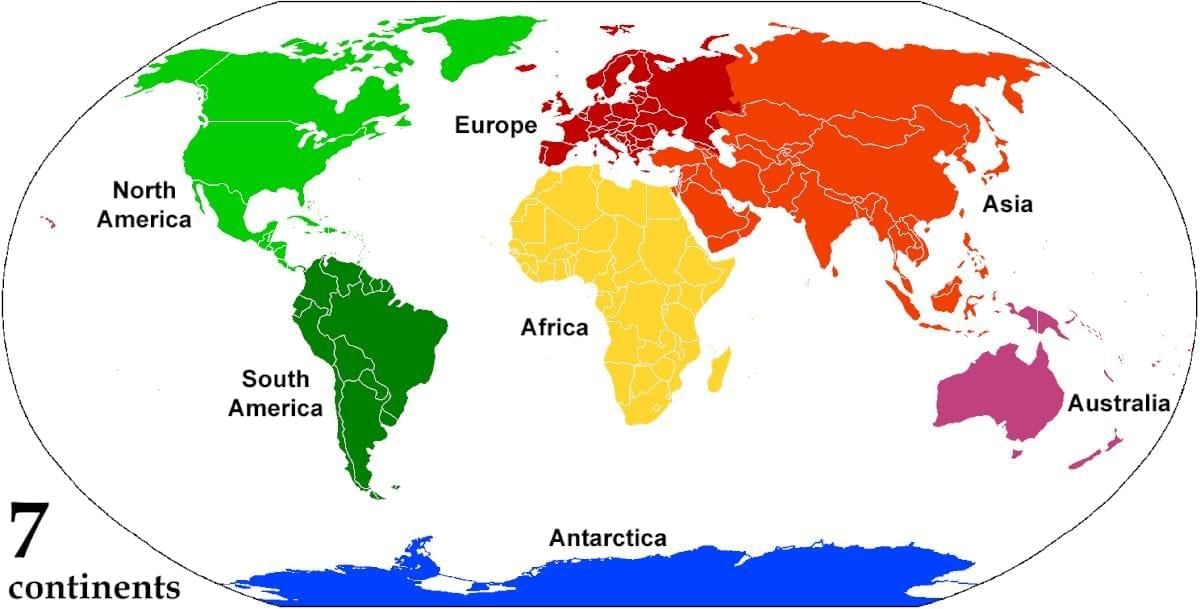
Geographical Facts
- About 71% of Earth is covered by water.
- The remaining 29% is land.
Long ago, the continents were joined together as a single landmass called Pangaea, but over time, geological forces caused them to drift apart. For instance, Europe and North America are still moving away from each other at a rate of about 7 cm per year, according to scientific research.
Introduction to the Continents
- Asia is the largest continent, both in size and population. It is known for its diverse cultures, languages, and landscapes, ranging from vast deserts to towering mountains.
- Africa is rich in natural resources and biodiversity, home to the Sahara Desert, the Nile River, and a wide variety of wildlife. It has a diverse range of cultures and languages.
- Europe is known for its historical significance, cultural diversity, and economic power. It is home to many countries with rich histories and varied landscapes, from the Alps to Mediterranean coastlines.
- Australia is both a country and a continent, known for its unique wildlife, such as kangaroos and koalas, and natural wonders like the Great Barrier Reef and Uluru.
- North America features a wide range of environments, from the Arctic tundra of Canada to the deserts of Mexico. It is known for its economic power and cultural influence, particularly the United States.
- South America is famous for its biodiversity, including the Amazon rainforest, and cultural heritage, with a mix of Indigenous, African, and European influences.
- Antarctica is the least populated continent, covered in ice and home to unique wildlife such as penguins. It is primarily used for scientific research due to its extreme conditions.
Each continent plays a vital role in the Earth's ecosystem and human culture, contributing to the planet's diversity and richness.
1. South America
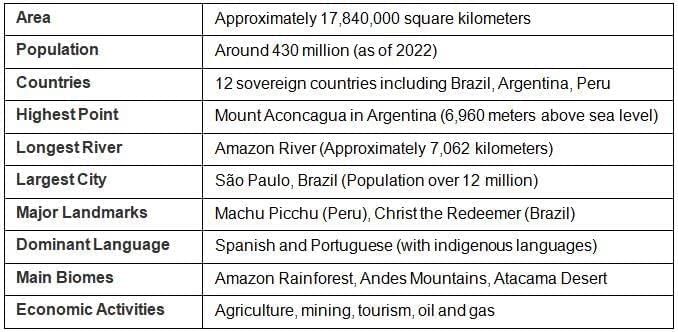
- South America is the leading continent among the seven continents.
- It is home to the Amazon River, which is the largest river in the world by volume and the second-longest, measuring 6,440 kilometers in length.
- South America features Angel Falls, known as the highest waterfall on Earth.
- The green anaconda, recognized as the largest snake by size and the second-longest, inhabits the continent's rich ecosystem.
- In South America, you can find impressive mountains like Mt. Cotopaxi and Mt. Chimborazo, which are the tallest volcanoes in the world.
2. North America
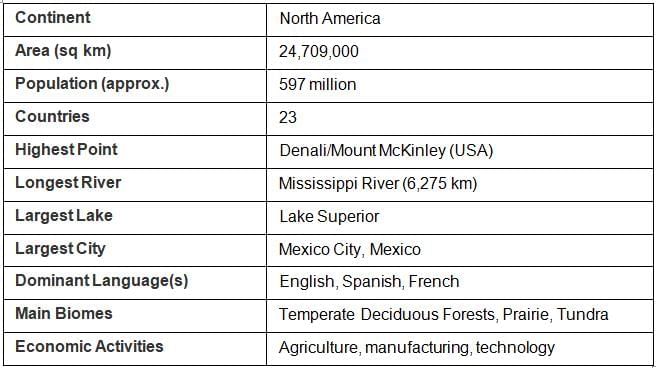
North America ranks second among the seven continents. Here are some intriguing features of this continent:
- Distinct Time Zones: North America is unique in having five different time zones.
- Diverse Climates: The continent experiences a wide range of climatic conditions.
- The New World: Often referred to as the "New World," North America is named after the explorer Americo Vespucci.
Population and Geography
- Highest Population Density: North America has the highest population density, with 22.9 people per square kilometre.
- Lake Superior: The continent is home to Lake Superior, the largest freshwater lake in the world.
- Mississippi River: The Mississippi River, measuring 3,778 kilometres, is the third-longest river in the world.
Economic Strength
- Economic Power: North America is known for its high average income per person.
- USA's Economy: The continent includes the United States, which has the largest economy in the world.
Agricultural Production
- Global Food Supply: North America plays a vital role in the global food supply.
- Major Crop Production: The continent is the largest producer of maize, wheat, and soybeans.
- Cuban Sugar Production: While Cuba is a significant sugar producer in North America, it is not the largest exporter.
3. Antarctica
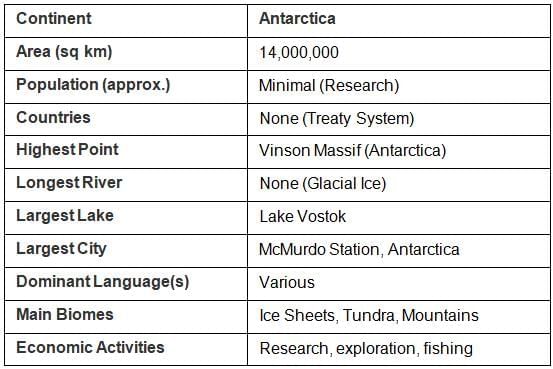
Antarctica ranks third among the seven continents. It holds the distinction of being not only the coldest but also the highest, driest, windiest, and least populated continent on Earth. This unique combination makes it a fascinating place. Antarctica is home to a staggering 75% of the world’s ice and 70% of its freshwater, which is why it is often called the “Frozen Continent” or the “White Continent.”
Daylight and Darkness
- In the past, Antarctica was known as ‘Terra Australis Incognita,’ which means “undiscovered southern continent.”
- The continent experiences extreme variations in daylight:
- From December to February, Antarctica enjoys continuous 24-hour daylight.
- From late March to late September, the continent remains in darkness.
Temperature Records
- In the interior of Antarctica, temperatures can plummet to around -35 degrees Celsius.
- Coastal areas are relatively warmer, with average temperatures around 2 degrees Celsius.
- Antarctica holds the record for the coldest natural temperature ever recorded on Earth: -89 degrees Celsius, observed at Vostok Station in July 1983.
Human Presence and Wildlife
- There are no time zones in this frozen land.
- The only permanent settlements in Antarctica are research bases, where scientists from around the world come to conduct their work.
- Despite the harsh conditions, Adelie penguins thrive in this cold environment, creating a stark contrast with the barren landscapes around them.
4. Africa
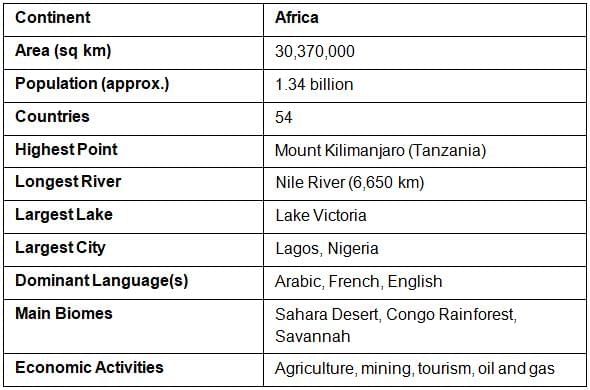
Africa is the second-largest continent, following Asia, and is renowned for its incredible diversity. Once considered difficult to explore, it is often referred to as "the Continent of Diversity." Africa is home to the world's longest river, the Nile, and the largest desert, the Sahara, which gives it a unique and significant status.
Ethiopia, a country within Africa, is known for its extreme temperatures, particularly in its lowland regions. Because Africa is situated on the equator, it receives abundant sunlight throughout the year. Interestingly, it is believed that Homo sapiens, our early human ancestors, first emerged on this continent before spreading to other parts of the world.
Africa's land is incredibly rich in minerals, producing more than half of the world's gold and a staggering 95% of its diamonds. Additionally, 66% of the world's cocoa is sourced from Africa. The continent is also famous for its diverse and unique wildlife, which includes:
- Cheetahs
- African elephants
- Lions
- Zebras
- Egyptian mongooses
- Giraffes
- Addaxes
This remarkable wildlife contributes to Africa's importance and significance on a global scale.
5. Europe
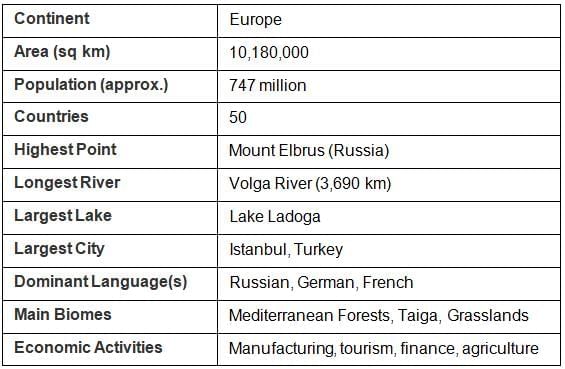
Europe ranks fifth among the seven continents. It is known for its intriguing mix of geography and culture. Although Europe and Asia are separated by the Ural Mountains and the Caspian Sea, they are part of the same large landmass. The highest point in Europe is Mt. Elbrus, which contributes to the continent's stunning landscape.
Geographical Features
- Major mountain ranges in Europe include the Balkans, Pyrenees, Apennines, Cantabrian, and Dinaric Alps.
- The Vatican City, the smallest country in the world, is situated within Europe.
- Important rivers in Europe are the Danube, Elbe, Loire, Oder, Dnieper, and Don rivers.
- The Trans-Siberian Rail Route primarily runs through Russia, connecting cities from Moscow to Vladivostok.
Agricultural Significance
- The Steppe region in Ukraine is commonly known as the “World’s Granary” or “World’s Bread Basket” due to its rich agricultural production.
- Moscow is often called the “Port of Five Seas” because it connects five seas through an extensive network of rivers and canals.
- Europe produces about three-quarters of the world’s potato s.
- The Volga River is the longest river in Europe.
6. Australia
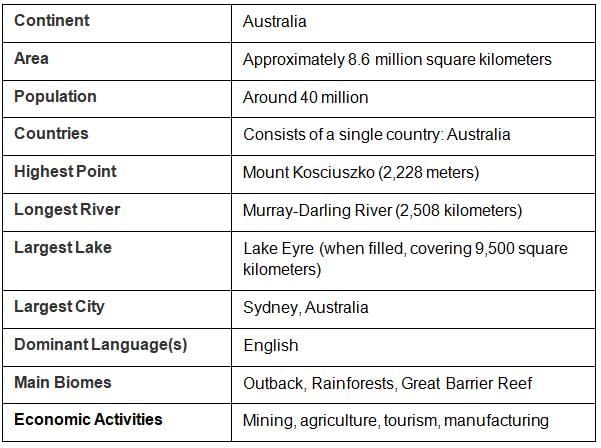
Australia is one of the seven continents and is known as a unique "island continent" because it is completely surrounded by oceans. Officially called the Commonwealth of Australia, it is the smallest continent in the world. Due to its geographical location in the southern part of the globe, Australia is often referred to as "down under." The name "Australia" comes from the Latin word "australis," which means "southern."
Wool Production in Australia
- One of the fascinating things about Australia is its remarkable wool production and export.
- This is made possible by a sheep population that is about 14 times larger than the human population in the country.
7. Asia
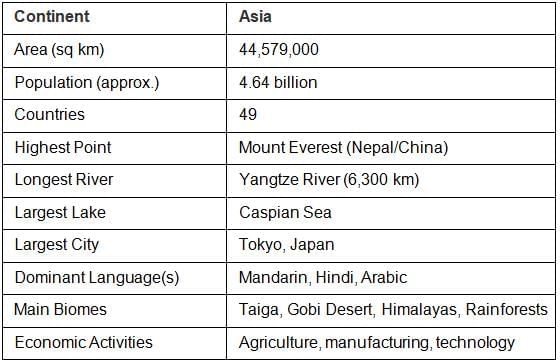
Asia, the seventh continent on our list, is a vast land known for its size and the number of people who live there. It covers a third of the Earth’s surface, making it the largest continent. Asia holds 30% of the planet’s land area and is home to an astonishing 60% of the world’s population.
Geographical Importance
- Asia includes many important countries, such as Russia, which is the largest country in the world.
- China and India are the two countries with the highest populations globally.
- The continent is famous for its breathtaking landscapes, including Mount Everest, which stands at 29,028 feet (8,848 meters) tall. Asia is home to ten of the tallest mountains in the world.
Cultural Significance
- The Great Wall of China is a remarkable feat of engineering and is said to be so large that it can be seen from space.
- Asia is a major centre for ancient civilisations, including the Harappan and Chinese civilisations.
- The continent is the origin of several major religions, such as Hinduism, Islam, Buddhism, and Christianity.
The Five Oceans of the World
The Earth is made up of a mix of land and water. It has seven big pieces of land called continents and five large bodies of water known as oceans. These oceans cover more than 70% of the Earth’s surface and are very important for the planet’s climate and all the living things in the water. Each ocean is different and plays a special role in connecting the continents, influencing the weather, and supporting various ecosystems.
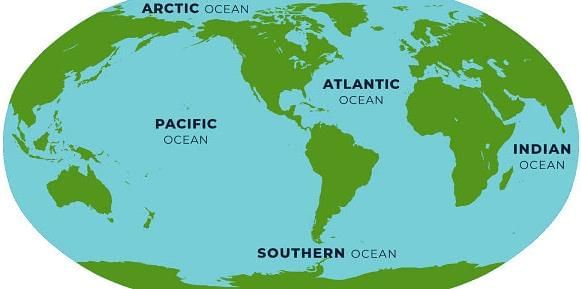
The Five Oceans
Here is a list of the five oceans:
- Pacific Ocean
- Atlantic Ocean
- Indian Ocean
- Arctic Ocean
- Southern Ocean
1. Pacific Ocean
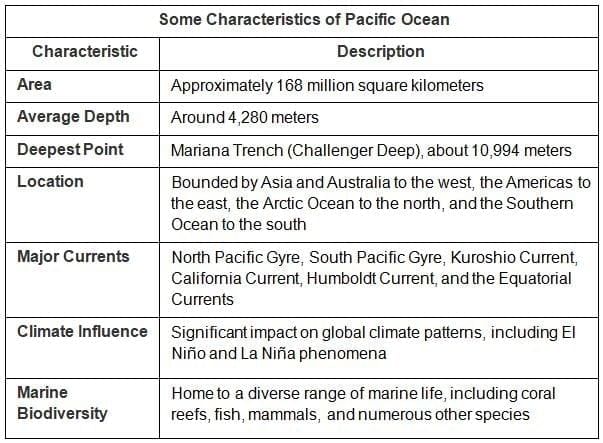
- The Pacific Ocean is the largest and deepest ocean on Earth, covering about 46% of the planet’s water surface. It is so big that its area is greater than all the land on Earth combined. The Mariana Trench, located in this ocean, is the deepest point on Earth.
2. Atlantic Ocean
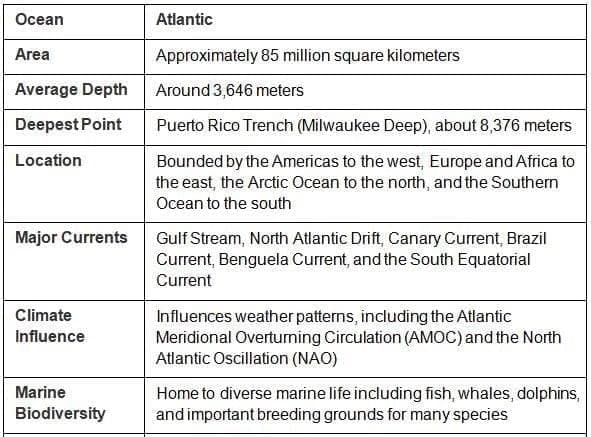

- The Atlantic Ocean is the second-largest ocean, covering around 85 million square kilometres. It is bordered by the Americas to the west and Europe and Africa to the east. The average depth of the Atlantic Ocean is about 3,646 metres, with the deepest point being the Puerto Rico Trench, which reaches around 8,376 metres. This ocean plays a crucial role in global climate by influencing weather patterns through systems like the Atlantic Meridional Overturning Circulation (AMOC) and the North Atlantic Oscillation (NAO).
3. Indian Ocean
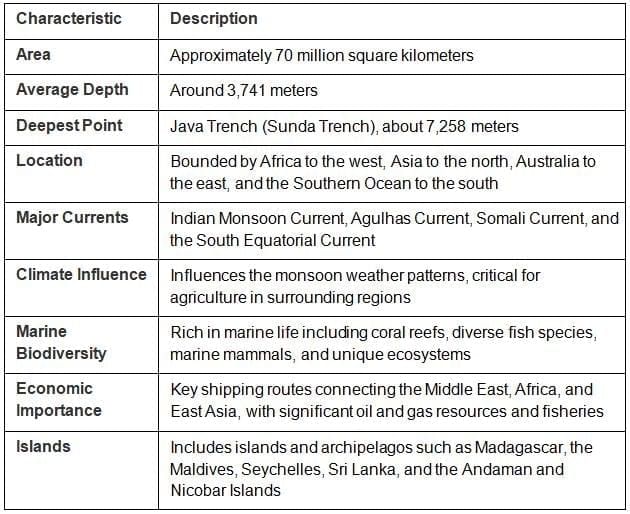
- The Indian Ocean is the third-largest ocean, covering about 20% of the Earth’s water surface. It is bordered by Australia to the east, Africa to the west, and Asia to the north, with the Southern Ocean extending southward from it.
4. Southern Ocean
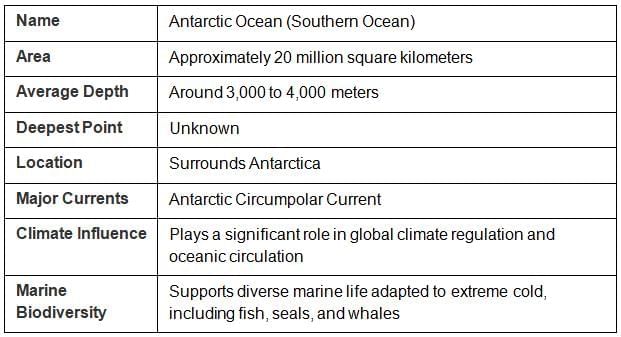
- The Southern Ocean, also known as the Antarctic Ocean, surrounds the continent of Antarctica. This ocean is characterized by icy landscapes and harsh conditions but is crucial for shaping the Earth’s climate and ocean currents. Despite its extreme environment, the Southern Ocean supports a rich variety of marine life adapted to its unique conditions, including towering icebergs and diverse ecosystems.
5. Arctic Ocean
- The Arctic Ocean is the smallest and shallowest of the major oceans, located at the top of the world. Its icy surface is melting rapidly due to climate change, which affects sea levels and local ecosystems. The Arctic Ocean is home to wildlife such as polar bears and seals, and the changes happening in this delicate region highlight the need for global conservation efforts.
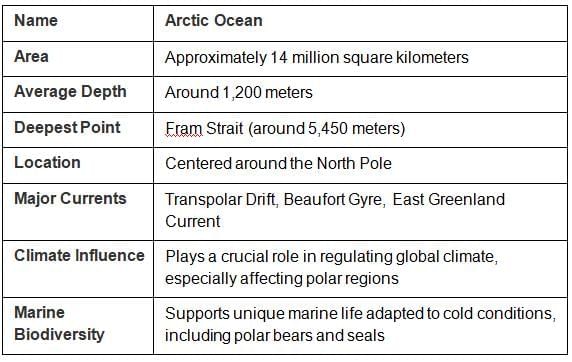
|
1335 videos|1436 docs|834 tests
|
FAQs on 7 Continents and 5 Oceans - SSC CGL Tier 2 - Study Material, Online Tests, Previous Year
| 1. What are the seven continents of the world and their key characteristics? |  |
| 2. How many oceans are there in the world, and what are their names? |  |
| 3. What is the significance of studying the continents and oceans for exams like SSC CGL? |  |
| 4. Can you explain the geographical features of Antarctica? |  |
| 5. How do the geographical features of Australia differ from those of other continents? |  |

















